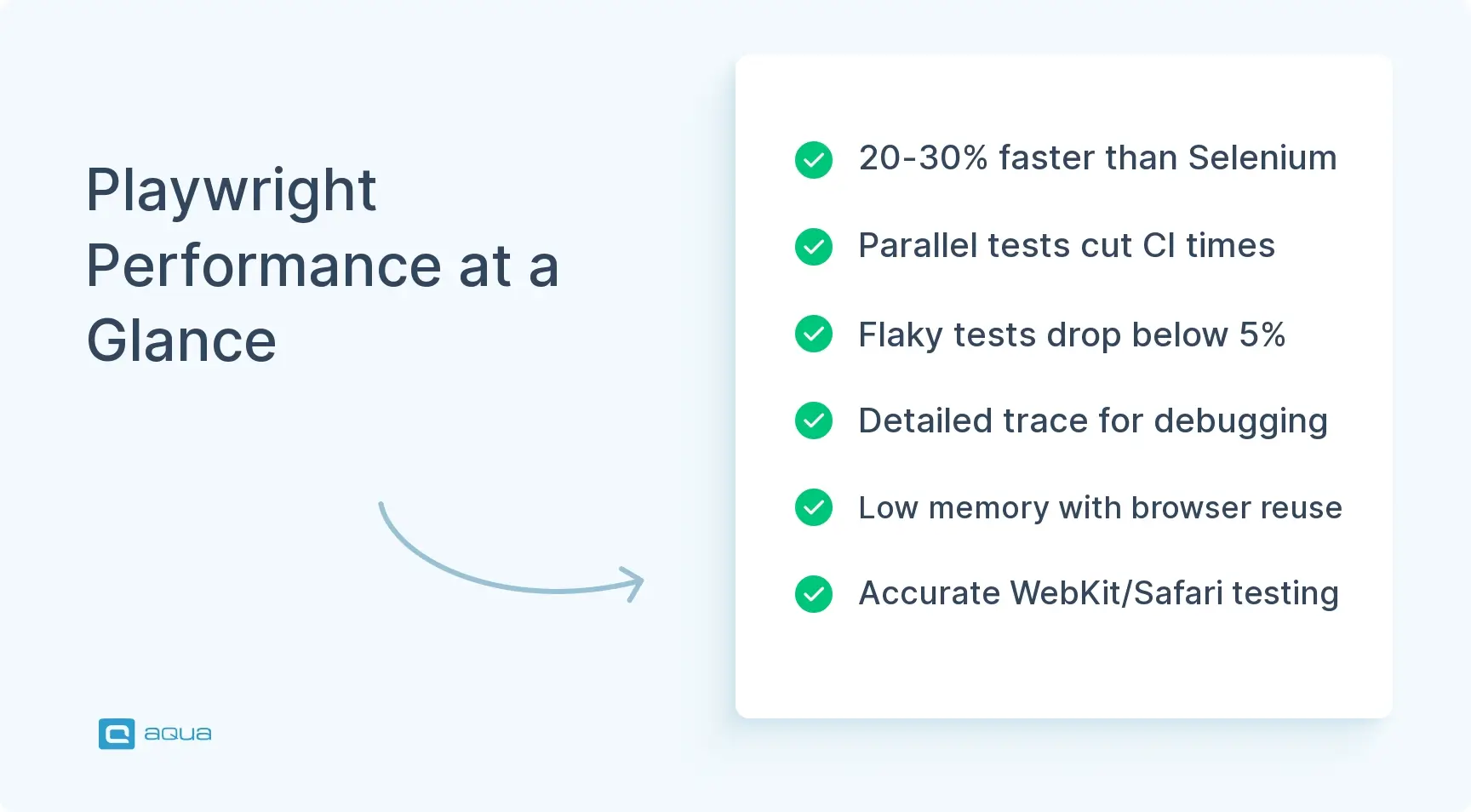Key takeaways
- Playwright is an open-source, cross-browser automation framework developed by Microsoft for end-to-end testing of web applications.
- The framework has great browser automation speed but requires programming expertise to use effectively.
- Teams often spend up to 50% of their time on test maintenance rather than creating new tests.
- Flaky tests remain a problem, causing unpredictable CI/CD pipeline failures.
- Playwright lacks native test management capabilities, requiring third-party tools for proper test case organization and reporting.
- Mobile testing support is limited to browser emulation. Real device testing requires additional tools.
Have you considered using Playwright for your test automation? It’s quickly become one of the most talked-about frameworks out there. The speed and cross-browser capabilities earn genuine praise. The numbers back it up too: over 74,000 GitHub stars, 3.2 million weekly npm downloads, and community surveys showing usage that exceeds Selenium among many respondents. But implementing Playwright in your QA workflow reveals challenges that often get overlooked. Here’s what development and QA teams actually experience with Playwright daily.👇
What Is Playwright?
Playwright is an open-source automation framework developed by Microsoft. It handles end-to-end testing of web applications across multiple browsers and platforms. Released in 2020 by the team behind Puppeteer, Playwright lets developers write automated tests using a single API. That API works across Chromium, Firefox, and WebKit browsers.
The framework supports JavaScript, TypeScript, Python, Java, and C#. Its architecture provides auto-waiting for elements, network interception, and parallel test execution. These features make it attractive for teams looking to automate web application testing.
Is Playwright the right choice for your QA team in 2025? That depends on your team’s technical capabilities and testing needs.
How Does Playwright Work?
Playwright communicates directly with browsers using native protocols, which is different from the WebDriver approach that Selenium uses. Tests execute faster and with more reliability than traditional automation frameworks. The framework installs browser binaries automatically, eliminating driver management headaches.
When you write a Playwright test, you use locators to find elements, then actions to interact with them. The framework handles waiting automatically, which reduces flaky tests in most scenarios. Tests can run in manual mode for debugging or automated mode for CI/CD pipelines.
Who Uses Playwright?
Playwright is in demand among dev teams and technical QA engineers comfortable with code-based testing. Microsoft, Adobe, and various startups have adopted the framework for web application testing. Industry surveys show Playwright now holds roughly 15% market share in test automation, with strong year-over-year growth.
Typical Playwright users include:
- Frontend developers writing tests for their own code
- SDETs and automation engineers building test frameworks
- DevOps teams integrating E2E tests into CI/CD pipelines
- QA engineers with programming backgrounds
- Teams migrating from Selenium or Cypress
Mid-sized to large organizations with dedicated automation engineers usually get the most value from Playwright.
Playwright Features
Playwright is popular because of its modern approach to browser automation and cross-browser support. When teams scale their test suites, certain limitations start to show up. Here’s what Playwright actually delivers.
Test Script Creation
Playwright provides a code-first approach to test creation. Developers appreciate the flexibility. The framework includes Codegen, a tool that records browser interactions and generates test code automatically.
Playwright offers for test creation:
- Auto-generated test scripts from browser recording
- Support for multiple programming languages
- Built-in test runner with TypeScript support
- VS Code extension for debugging
This code-centric approach creates barriers for some teams. Manual testers and business stakeholders cannot participate in test creation without programming knowledge.
Nothing particular, it is just the same problem as with other test automation frameworks. You need to have an SDET to maintain it.
This dependency on specialized engineers creates bottlenecks in QA. Valuable domain expertise from non-technical team members often goes unused.
Manage all your testing in one place, including Playwright automation
Playwright automates browsers well, but automation results need a unified platform. Test data spread across repositories, spreadsheets, and Jira tickets creates blind spots that drag out your releases. aqua cloud consolidates everything with AI-powered test and requirement management. Import your Playwright results alongside manual tests, exploratory sessions, and other automation tools in one unified interface. See coverage gaps instantly with 100% traceability from requirements to test cases to defects. aqua’s AI Copilot generates complete test cases from documentation, text, and voice notes in seconds, saving manual effort. With support responses under 2 hours from engineers who understand testing, aqua fits into your existing workflow without friction. Connect through 12 out-of-the-box integrations, including Jira, Azure DevOps, and Selenium, plus a REST API for custom connections. No more managing test data in multiple applications.
Save 97% time on test case creation with AI-powered automation
Cross-Browser Testing
Playwright’s primary strength is cross-browser support. The framework supports Chromium, Firefox, and WebKit through a unified API. Teams can run the same tests across multiple browsers without modification.
Key capabilities include:
- Single API for Chrome, Firefox, and Safari testing
- Mobile device emulation for responsive testing
- Parallel test execution across browsers
- Automatic browser binary management
Playwright is used by the people who develop NASA technology, so, pretty reliable.
Playwright doesn’t support legacy browsers or real mobile devices. For mobile testing, you’re limited to emulation, which doesn’t really capture what users experience on actual hardware. If you need comprehensive mobile testing or support for older browsers, you’ll need to bring in additional tools.
Auto-Waiting and Reliability
Playwright’s auto-waiting mechanism is one of its most praised features. The framework automatically waits for elements to be actionable before performing interactions. This theoretically eliminates the need for explicit waits and reduces test flakiness.
Features include:
- Automatic waiting for element stability
- Web-first assertions with retry logic
- Configurable timeout values
- Network request interception
Flakiness 9/10 times is to do with the people using the tool rather than the tool itself. Playwright won't save you from using it poorly, but it offers a lot to save you from yourself.
Despite these features, flaky tests remain a significant problem for many Playwright users. Auto-waiting works in most scenarios. Complex UIs, third-party components, and dynamic content often require manual intervention.
The main adjustment for me was that Playwright doesn't seem to automatically wait for actionability before performing actions such as click, etc. I am manually having to wait for elements to be attached and visible/not animating before actions. Also, you have to await every async call, which is kind of annoying.
Teams report spending significant time debugging timeout issues. Elements that Playwright considers “actionable” sometimes aren’t truly ready for interaction.
Debugging and Tracing
Playwright offers impressive debugging tools. The Trace Viewer provides a complete timeline of test execution, including screenshots, DOM snapshots, and network activity.
Available debugging features:
- Trace Viewer for post-mortem analysis
- VS Code extension with step-through debugging
- Video recording of test execution
- Screenshot capture on failure
Using these tools effectively requires technical expertise. Non-technical stakeholders cannot easily interpret trace files or debug failed tests. The learning curve for mastering Playwright’s debugging capabilities is substantial.
You need to learn async/await patterns, handle timeouts, and understand advanced Playwright features like browser contexts or multiple-page handling to get going with Playwright test automation, which is definitely difficult.
Integrations with Other Tools
Playwright provides integration capabilities with CI/CD systems. Teams can connect it to various third-party tools through community-maintained plugins and custom implementations.
Integration options include:
- GitHub Actions, GitLab CI, and Azure DevOps support
- JUnit XML report generation for test management tools
- Custom reporter capabilities
- API for programmatic control
With Playwright we automated the critical path, we integrated it into our CI/CD, and now it's constantly running and detecting errors and bugs before they even reach to QA.
Playwright doesn’t include native test management capabilities. Integrations with test management systems require additional setup, custom code, or third-party plugins. This adds complexity and creates extra maintenance work. When you’re using Playwright on its own, it’s tough to keep track of how requirements, test cases, and defects all connect.
Connect Playwright to your complete QA ecosystem
aqua cloud comes with 12+ out-of-the-box integrations including Jira, Azure DevOps, Selenium, and Jenkins. Import Playwright results seamlessly and see them alongside all your other testing data. Maintain complete visibility and traceability across your entire QA process without custom development.
Save up to 70% of time on manual work
User Experience & Interface
Playwright’s usability varies based on technical background. Developers comfortable with code generally appreciate the framework’s API and comprehensive documentation. The experience differs for teams without strong programming backgrounds.
The code-centric interface means every interaction requires writing and maintaining scripts. There’s no visual interface for test creation, execution monitoring, or results analysis built into the core framework. Your team need to either use the command line or configure IDE extensions.
If you're completely new to test automation, there's a bit of a learning curve, and sometimes the error messages can be a little cryptic.
It makes automating complex user interactions easier, fits right into our CI/CD for continuous testing, and works great across different browsers. The Documentation is a plus, you don't really need to search a lot to understand and find what you need for the coding.
The VS Code extension provides helpful features like test discovery and step-through debugging. It assumes familiarity with development tools that many QA professionals may not possess.
Reporting and Analytics
Playwright’s built-in reporting capabilities are functional but limited. The default HTML reporter shows test results, screenshots, and trace files. It lacks the analytical depth needed for enterprise QA management.
Users report these limitations:
- No built-in trend analysis or historical comparisons
- Limited test coverage visualization
- No native requirement traceability
- Basic pass/fail reporting without detailed analytics
Teams seeking comprehensive reporting must implement custom reporters or integrate with third-party platforms.
Test Maintenance Challenges
Test maintenance is where Playwright’s limitations become most apparent. As test suites expand, maintaining test scripts can become overwhelming.
When the test suite size in Playwright is huge, many teams spend up to 50% of their time on test maintenance rather than on more productive tasks. You could have used this time to create more robust new tests. However, this precious time is being spent on maintenance.
Common maintenance challenges include:
- Locator fragility: UI changes break selectors, requiring constant updates
- Timeout adjustments: Performance variations necessitate timeout tuning
- Dependency management: Browser and library updates can break existing tests
- Third-party app changes: Testing systems you don’t control requires constant adaptation
Our Java tests were pretty flaky with Playwright.
Without self-healing capabilities, every element property change can cause test failures. This creates a continuous cycle of test repair that drains team resources.
Language-Specific Experiences
I think it was built first and foremost NodeJS. I have had issues with the .net implementation, missing features, async click event not actually waiting. I am now wondering if I should have stuck with Selenium.
If your team is using Java, Python, or .NET bindings, you might run into missing features or behavior that doesn’t quite match the JavaScript/TypeScript version.
Performance and Parallelization
Playwright lets you run however many tests you want on your node.js process, as long as your machine can handle it; gives you sharding out-of-the-box or even if that's still not enough, you can just plug it on a Selenium Grid, and that's it.
Playwright does seem to be more perf, though, so it's a trade-off.
This performance advantage helps you run large test suites efficiently. It doesn’t eliminate the maintenance burden that comes with scaling, though.
Learning and Onboarding
I was able to get a Junior QA Engineer up to speed on Playwright in about a week. His tests are no less reliable than if they were written with Cypress. I have a cicd workflow that runs its tests 5 times in parallel before I merge its PRs to ensure the majority of flakes are shaken off.
If you’re new to test automation, you’ll face a steeper learning curve, especially around async patterns and browser contexts.
Comparison with Other Frameworks
I always hated UI automation frameworks, until I met Playwright. I hate Cypress and I don't like Selenium.
I can understand Selenium, as you've got to manage all the drivers and then handle waits and page loads yourself; it's old news now. Cypress is lovely, though. The async chainable design is weird to get around, but once you understand it, it's fine.
Playwright’s API design and feature set appeal to developers who find Selenium outdated and Cypress limiting. However, preference often depends on team composition and project requirements.
Summary & Key Insights

After analyzing user feedback across G2, GitHub, Stack Overflow, Reddit, and real-world implementations, clear patterns emerge. Playwright excels in specific areas while presenting genuine challenges in others. Here are the platform ratings of Playwright:
- Techjockey: 4.5/5
- Trustradius: 8.6/10
- G2: 4.8/5
- Other platforms and forums: Mixed reviews
Here’s a balanced assessment based on what teams actually report.
Pros of Playwright
- Free and open-source with no licensing costs
- Fast test execution through native browser protocols
- Excellent cross-browser support for Chromium, Firefox, and WebKit
- Comprehensive debugging tools, including Trace Viewer
- Active development with frequent updates from Microsoft
- Built-in parallelization without external infrastructure
- Cleaner API compared to Selenium
Cons of Playwright
- Steep learning curve requiring programming expertise
- High maintenance burden that can consume 50% of team time
- No native test management capabilities for enterprise QA
- Limited mobile testing with emulation only
- Flaky test issues despite auto-waiting mechanisms
- Integration complexity requires custom development for TMS tools
- No AI-powered test generation for accelerated test creation
- Excludes non-technical team members from test creation
- Basic reporting that requires third-party tools for analytics
- Locator maintenance challenges when UIs change frequently
- Language-specific implementation gaps (particularly for Java, .NET, Python)
- Manual waiting is still required for complex UI scenarios
Managing Playwright Tests: Why You Need More Than Just Automation
Playwright handles browser automation well, but automation is just one piece of your QA process. You still need to manage test cases, track requirements, report defects, and maintain traceability.
Teams using Playwright may struggle with a complicated workflow. That’s because automated tests live in code repositories, while manual test cases sit in spreadsheets or separate tools. Defects go into yet another system. Requirements exist somewhere else entirely. This fragmentation creates blind spots and slows down releases.
A test management platform brings everything together. Import Playwright results alongside manual testing efforts. Link tests to requirements. Track defects from discovery to resolution. See coverage gaps at a glance. Make decisions based on complete information rather than scattered data.
aqua cloud: Unified Test Management for All Your Testing Needs
For your QA work, aqua provides what Playwright lacks: one centralized platform for your entire testing lifecycle. Manage requirements, test cases, defects, and projects in one place. Import results from Playwright and other automation tools. Get AI-powered test case generation that saves 98% of creation time.
Why teams choose aqua cloud alongside Playwright:
- AI Copilot: Generate test cases from requirements, documentation, or voice notes
- Complete traceability: Link requirements to tests to defects automatically
- Unified platform: Manual and automated testing in one interface
- Enterprise support: Get answers from testing experts, not ticket queues
- Seamless integrations: Connect to Jira, Azure DevOps, Jenkins, and more
Playwright handles automation for your QA. aqua cloud, an AI-powered test and requirement management platform, handles the rest. Track test execution history across every run, identify flaky patterns before they derail releases, and report quality metrics to stakeholders from one unified platform. No more piecing together information from multiple tools and manual traceability mapping in spreadsheets. aqua’s purpose-built architecture handles repositories with thousands of test cases without the slowdowns that plague add-on tools. The platform combines test management, requirements management, and defect tracking with AI that actually accelerates your work. When questions arise, get answers from engineers with 20 years of testing expertise, not ticket queues that take weeks to respond. Connect your existing workflow through 12 out-of-the-box integrations, including Jira, Confluence, Azure DevOps, Jenkins, and Selenium, plus a REST API for custom connections.
Cut testing time by 80% with AI-driven test management
Conclusion
Playwright deserves its reputation as a capable browser automation framework. The cross-browser support, modern architecture, and debugging tools make it a solid choice for technical teams. However, the steep learning curve and high maintenance burden create challenges, with teams spending up to 50% of their time on test upkeep. The framework works best when paired with proper test management. For teams evaluating their testing strategy in 2025, consider how Playwright fits into your complete QA process. Automation is one part. Effective test management ties it all together.

















